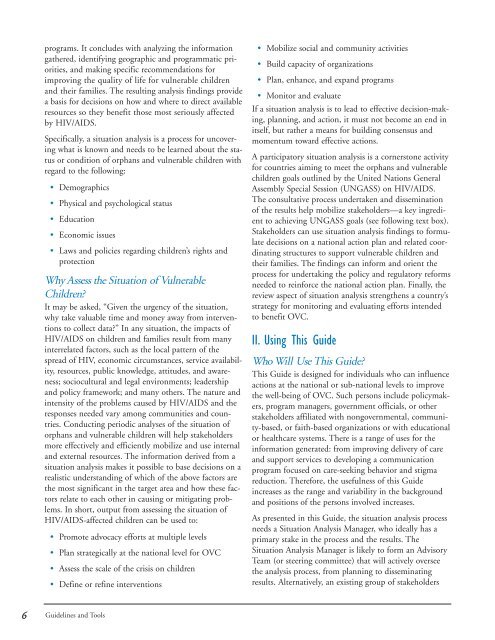Conducting a Participatory Situation Analysis of.pdf - Global HIV ...
Conducting a Participatory Situation Analysis of.pdf - Global HIV ...
Conducting a Participatory Situation Analysis of.pdf - Global HIV ...
You also want an ePaper? Increase the reach of your titles
YUMPU automatically turns print PDFs into web optimized ePapers that Google loves.
programs. It concludes with analyzing the information<br />
gathered, identifying geographic and programmatic priorities,<br />
and making specific recommendations for<br />
improving the quality <strong>of</strong> life for vulnerable children<br />
and their families. The resulting analysis findings provide<br />
a basis for decisions on how and where to direct available<br />
resources so they benefit those most seriously affected<br />
by <strong>HIV</strong>/AIDS.<br />
Specifically, a situation analysis is a process for uncovering<br />
what is known and needs to be learned about the status<br />
or condition <strong>of</strong> orphans and vulnerable children with<br />
regard to the following:<br />
• Demographics<br />
• Physical and psychological status<br />
• Education<br />
• Economic issues<br />
• Laws and policies regarding children’s rights and<br />
protection<br />
Why Assess the <strong>Situation</strong> <strong>of</strong> Vulnerable<br />
Children?<br />
It may be asked, “Given the urgency <strong>of</strong> the situation,<br />
why take valuable time and money away from interventions<br />
to collect data?” In any situation, the impacts <strong>of</strong><br />
<strong>HIV</strong>/AIDS on children and families result from many<br />
interrelated factors, such as the local pattern <strong>of</strong> the<br />
spread <strong>of</strong> <strong>HIV</strong>, economic circumstances, service availability,<br />
resources, public knowledge, attitudes, and awareness;<br />
sociocultural and legal environments; leadership<br />
and policy framework; and many others. The nature and<br />
intensity <strong>of</strong> the problems caused by <strong>HIV</strong>/AIDS and the<br />
responses needed vary among communities and countries.<br />
<strong>Conducting</strong> periodic analyses <strong>of</strong> the situation <strong>of</strong><br />
orphans and vulnerable children will help stakeholders<br />
more effectively and efficiently mobilize and use internal<br />
and external resources. The information derived from a<br />
situation analysis makes it possible to base decisions on a<br />
realistic understanding <strong>of</strong> which <strong>of</strong> the above factors are<br />
the most significant in the target area and how these factors<br />
relate to each other in causing or mitigating problems.<br />
In short, output from assessing the situation <strong>of</strong><br />
<strong>HIV</strong>/AIDS-affected children can be used to:<br />
• Promote advocacy efforts at multiple levels<br />
• Plan strategically at the national level for OVC<br />
• Assess the scale <strong>of</strong> the crisis on children<br />
• Define or refine interventions<br />
• Mobilize social and community activities<br />
• Build capacity <strong>of</strong> organizations<br />
• Plan, enhance, and expand programs<br />
• Monitor and evaluate<br />
If a situation analysis is to lead to effective decision-making,<br />
planning, and action, it must not become an end in<br />
itself, but rather a means for building consensus and<br />
momentum toward effective actions.<br />
A participatory situation analysis is a cornerstone activity<br />
for countries aiming to meet the orphans and vulnerable<br />
children goals outlined by the United Nations General<br />
Assembly Special Session (UNGASS) on <strong>HIV</strong>/AIDS.<br />
The consultative process undertaken and dissemination<br />
<strong>of</strong> the results help mobilize stakeholders—a key ingredient<br />
to achieving UNGASS goals (see following text box).<br />
Stakeholders can use situation analysis findings to formulate<br />
decisions on a national action plan and related coordinating<br />
structures to support vulnerable children and<br />
their families. The findings can inform and orient the<br />
process for undertaking the policy and regulatory reforms<br />
needed to reinforce the national action plan. Finally, the<br />
review aspect <strong>of</strong> situation analysis strengthens a country’s<br />
strategy for monitoring and evaluating efforts intended<br />
to benefit OVC.<br />
II. Using This Guide<br />
Who Will Use This Guide?<br />
This Guide is designed for individuals who can influence<br />
actions at the national or sub-national levels to improve<br />
the well-being <strong>of</strong> OVC. Such persons include policymakers,<br />
program managers, government <strong>of</strong>ficials, or other<br />
stakeholders affiliated with nongovernmental, community-based,<br />
or faith-based organizations or with educational<br />
or healthcare systems. There is a range <strong>of</strong> uses for the<br />
information generated: from improving delivery <strong>of</strong> care<br />
and support services to developing a communication<br />
program focused on care-seeking behavior and stigma<br />
reduction. Therefore, the usefulness <strong>of</strong> this Guide<br />
increases as the range and variability in the background<br />
and positions <strong>of</strong> the persons involved increases.<br />
As presented in this Guide, the situation analysis process<br />
needs a <strong>Situation</strong> <strong>Analysis</strong> Manager, who ideally has a<br />
primary stake in the process and the results. The<br />
<strong>Situation</strong> <strong>Analysis</strong> Manager is likely to form an Advisory<br />
Team (or steering committee) that will actively oversee<br />
the analysis process, from planning to disseminating<br />
results. Alternatively, an existing group <strong>of</strong> stakeholders<br />
6<br />
Guidelines and Tools















